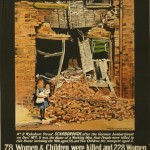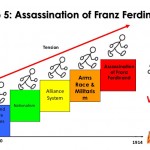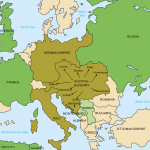7.1: (Re)Meet the -Ism Triplets
After Napoleon was defeated, a little less than 100 years before World War I, the governments of Europe sought to make sure that no “revolutionary” could attempt to unify Europe again. Part of the appeal of Napoleon’s message, like the Communist theory we once read about, was that it sought to achieve equality for all, regardless of nationality (at least, in theory).
Therefore, the best way of preventing such a “foreign” message was to strengthen national identity and focus on national heritage, culture, and superiority. This idea is called nationalism. Of course, any nation in Europe was considered—by Europeans—to be automatically better than any nation outside of the continent. So, how did Europeans rank themselves? How does one nation prove that it is “better” than its rivals?
The answer was two-fold: the first answer we have already seen in the past chapter: in order to be better, a country needs a bigger empire—as we know, this is called imperialism. The second answer is closely related: the main way to ensure that one’s nation could control a vast empire was through building a strong military (both armies and navies). Ideally, a nation’s military would maintain constant growth and ensure that neighboring European powers (and their African/Asian holdings) would not threaten it. This focus on military superiority leading to national superiority is called militarism.
Each one of these “-ism triplets” was born with the other two, and they are mutually dependent on each other. National pride cannot be proven to others without having more territory than others; that territory cannot be protected without a huge military to span the world. Naturally, the competition for power across the globe led to power struggles back in Europe. (So, the Africans were not the only victims of European imperialism—it was a lose-lose situation.)
The power struggles got so intense that “teams” were eventually formed based on alliances. If you are going to be fighting with Country X, you want to know that Countries Y and Z have your back. In the early 20th century, the “teams” were pretty much on lock:
The Triple Alliance (during WWI, changed to the “Central Powers” because they were all located in the center of the continent):
- Germany
- Austria-Hungary
- Italy
- Later, The Ottoman Empire (Turkey)
The Triple Entente (during WWI, changed to the “Allied Powers”):
- Great Britain
- France
- Russia
- Later: the small country of Serbia, in addition to:
- Japan
- Italy (after it switched sides in 1915)
If you remember our “good-factor/bad-factor” countries list from the industrialization chapter, and if you remember the Napoleonic Wars, this list will appear surprising: 1) good-factor countries had allied with bad-factor countries; and 2) for the first time, Great Britain and France were on the same side. 20th-century politics was a lot less predictable.
Something that could be predicted, though: with the smallest cause/excuse, if one country on the list were attacked by any other, every major European power would be at war.


